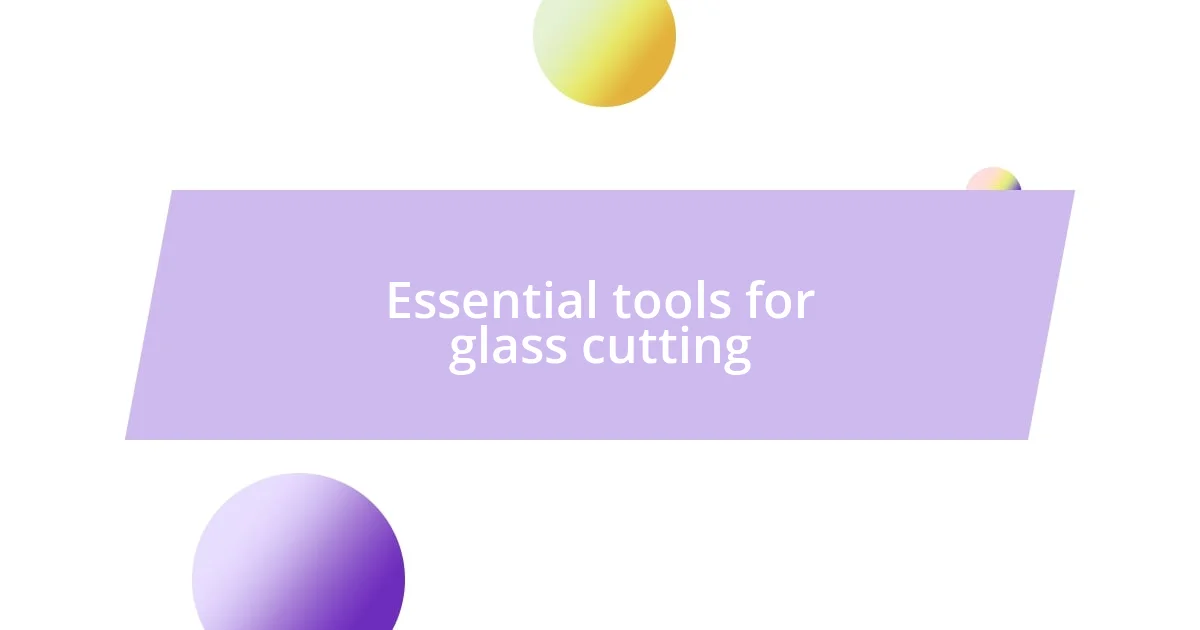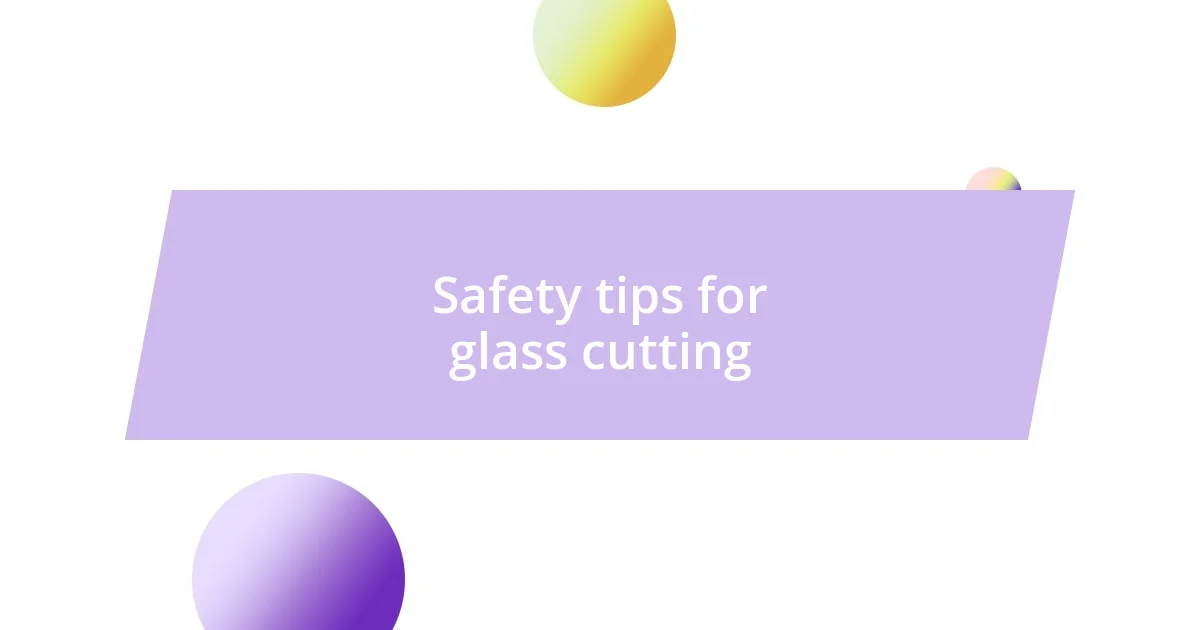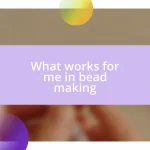Key takeaways:
- Mastering glass cutting hinges on understanding techniques such as scoring and breaking along score lines, emphasizing patience and confidence.
- Essential tools, including a quality glass cutter, running pliers, safety goggles, a sturdy work surface, and a precise marker, greatly enhance the cutting process.
- Safety must be prioritized through proper gear, a clean workspace, and adequate cutting space to prevent accidents and improve focus.

Understanding glass cutting techniques
When I first started cutting glass, I quickly realized that mastery comes from understanding various techniques. I remember my initial frustration when I tried to cut a straight line and ended up with jagged edges instead. It made me wonder—what is the secret to achieving that perfect clean cut?
One of the key techniques is scoring, which involves scratching the glass surface with a specially designed cutter. I was amazed when I discovered the magic of applying just the right amount of pressure. Too much pressure would shatter the glass, while too little wouldn’t score at all. This delicate balance is a lesson in patience, reminding me that sometimes we need to adjust our approach to see better results.
Then there’s the technique of breaking along the score line—a point where I learned the importance of technique over brute force. I often found myself hesitating, but watching an experienced glass cutter make it look so effortless inspired me. It made me realize that confidence plays a significant role; it’s as if the glass and the cutter are in a silent dialogue, trusting each other in the process. Have you ever felt that moment of clarity when everything just clicks into place?

Essential tools for glass cutting
When it comes to glass cutting, having the right tools can make all the difference. I remember my first attempt, armed only with a basic glass cutter and no real understanding of its parts. The reality hit me hard when my endeavor turned into a disaster. Over time, I learned that each tool serves a specific purpose, greatly influencing the outcome of my projects.
Here’s a list of essential tools I recommend for anyone serious about glass cutting:
- Glass Cutter: A good quality cutter with a carbide wheel is a must for scoring. I still recall the ease I felt when switching to a better cutter; it truly transformed my work.
- Running Pliers: These help to break glass cleanly along the scored line. When I first used them, it felt like having an extra set of hands!
- Safety Goggles: Protecting your eyes should never be an afterthought. I learned this the hard way, as a small shard flew unexpectedly during one of my projects.
- Work Surface: A sturdy and flat surface dedicated to glass work can prevent nasty accidents. Trust me, not having one can make a messy situation worse!
- Marker or Grease Pencil: These are essential for marking your cutting lines accurately. I always double-check my measurements before scoring; it saves so much time and frustration later.
Having the right tools equipped me with the confidence to tackle more ambitious projects. Each piece played a role not just in functionality but also in enhancing my overall experience—and believe me, that confidence is key!

Preparing glass for cutting
Preparing glass for cutting is crucial for achieving clean and precise results. One of my early experiences involved not properly cleaning the glass before scoring, leading to awful results. A few dust particles can throw off your entire project! Now, I always ensure that my glass is spotless—like it’s ready for a special occasion—before I begin marking my cuts. It’s a simple step that makes all the difference in how smoothly everything goes.
Once your glass is clean, it’s time to measure and mark your lines. I’ve learned the hard way that one small miscalculation can turn a carefully planned design into a jumbled mess. Using a precise marker, I take my time to double-check my measurements. After all, patience in the preparation phase really pays off when I finally score and break the glass along those lines.
After marking, it’s best to lay the glass on a sturdy surface, ensuring it’s properly supported. I remember once cutting a piece on an uneven table; it ended badly with a jagged crack that ruined everything. Since that day, I’ve made it a habit to check the stability of my work surface. A solid foundation is key—it’s like setting the stage for a successful performance.
| Step | Importance |
|---|---|
| Cleaning the Glass | Ensures no debris affects the scoring process. |
| Measuring and Marking | Accurate marks lead to cleaner cuts and better results. |
| Setting up a Stable Surface | Prevents unwanted movement and potential cracks during cutting. |

Mastering straight cuts in glass
Mastering straight cuts in glass requires not just the right tools, but also a certain finesse that comes with practice. I still remember the first time I attempted a long, straight cut. My hands shook a bit as I scored, eager to see if I could pull it off. It may sound simple, but controlling the pressure on the glass cutter is everything. Too much pressure can lead to unexpected breaks, while too little won’t score the glass effectively. Finding that sweet spot was an enlightening experience for me, one I hope to share with anyone struggling with their first cut.
As I got more comfortable with straight cuts, I discovered the importance of maintaining a consistent angle while scoring. It’s like riding a bike; once you find your rhythm, everything clicks. Occasionally, though, I would find myself veering off course, which could end up ruining a perfectly good piece of glass. Have you ever felt that frustration, when you know you can do better but a small distraction throws you off? That’s when I learned to focus—the task demands your full attention and even a fleeting moment can lead to a mishap.
Moreover, breaking the glass along the scored line was another learning curve. Early on, I was overly cautious, which led to uneven breaks. I felt like an artist afraid to commit to a brushstroke. But I soon learned that a confident, swift motion yielded cleaner edges. The sensation of cleanly snapping the glass was almost exhilarating, a definitive “ah-ha!” moment that underscored the satisfaction of mastering the craft. So, how do you measure success in glass cutting? For me, it’s the thrill of watching a well-scored line transform into a perfect break—each cut telling its own story of patience and practice.

Achieving intricate designs in glass
Once I ventured into creating intricate designs in glass, I quickly realized that patience is paramount. My first attempt at crafting an elaborate pattern—a floral motif, to be specific—left me with uneven scores and jagged pieces. It was disheartening! Now, when I design, I approach the process thoughtfully, breaking down complex shapes into manageable sections. This way, I stay focused and ensure each part receives the attention it deserves.
I’ve found that the choice of cutting techniques is crucial for achieving those delicate details. For instance, I often use a combination of traditional scoring and grinding to refine edges. I remember the first time I employed a wet saw for a swirl design. The soothing sound of the water cooling the blade contrasted sharply with my racing heartbeat as I carefully guided the glass through. That moment taught me the value of utilizing the right tool for the job. Have you ever felt the thrill of discovery when a new technique finally clicks?
What truly transforms a piece, however, is the final touch of creativity. I let my imagination run wild, often sketching designs on paper before even touching the glass. As I’ve learned, the best designs stem from a personal connection. I remember infusing my childhood memories of playing in a garden into a glass panel, and the process became not just an artistic endeavor, but a heartfelt experience. So, next time you sit down to cut glass, think about what personal story you want to tell. In doing so, you’re not just cutting glass; you’re weaving a narrative that resonates deeply.

Safety tips for glass cutting
When it comes to glass cutting, prioritizing safety is non-negotiable. I remember my first glass-cutting experience—I was so excited that I forgot to wear proper safety gear. That oversight resulted in a tiny shard flying into my eye, which was a painful reminder of why safety goggles are essential. Always make sure to wear gloves and goggles to protect yourself from potential cuts and stray pieces. Have you ever had a moment when you thought, “It won’t happen to me”? Trust me, safety should always come first.
Additionally, having a clean workspace can drastically reduce the risk of accidents. I learned this the hard way when I tripped over a stray piece of glass while trying to maneuver a larger sheet. Keeping your area tidy not only helps you find tools easily, but it also minimizes distractions that could lead to mishaps. Do you find that a clean workspace improves your focus? For me, it felt like a weight lifted off my shoulders, allowing me to concentrate solely on the task at hand.
Lastly, controlling your environment makes a world of difference in safety. I used to cut glass in my cramped garage, which often felt like trying to work on a tightrope. It wasn’t just uncomfortable; the limited space made it easy to knock things over or misjudge a cut. I switched to a well-lit, open area, and the transformation was incredible. Having ample room not only ensures greater precision but also keeps energy high. So, what’s your cutting space like? I encourage you to find a spot that feels just right for you—you’ll be amazed at how much easier and safer it can make the process.












